Abstract
To test the hypothesis that the primary defect in some patients with idiopathic hypopituitary dwarfism is failure to secrete hypothalamic hypophysiotropic-releasing factors, synthetic thyrotropin-releasing factor (TRF), 500 μg, wa given intravenously, and timed venous samples obtained for determination of the concentration of plasma TSH by radioimmunoassay in three groups of subjects: (a) 11 patients without evidence of endocrine or systemic disease, (group I) (b) 8 with isolated growth hormone deficiency and normal thyroid function, (group II) and (c) 9 patients with idiopathic hypopituitary dwarfism and thyroid-stimulating hormone (TSH) deficiency (group III). The mean fasting plasma TSH value was 4.1 μU/ml in group I, and 3.9 μU/ml in group II; in both groups there was a brisk rise in plasma TSH to peak levels of 12-45 μU/ml at 30-45 min, and a fall toward base line levels at 120 min. All children in group III had basal TSH levels of < 1.5 μU/ml; one failed to respond to TRF; eight exhibited a rise in plasma TSH with peak values comparable with those in groups I and II. In four of eight children in group III who responded to TRF, the TSH response was delayed and the initial rise in plasma TSH was not detectable until 10-60 min. In these four patients, plasma TSH levels continued to rise at 120 min.
The mean fasting concentration of plasma thyroxine iodide (T4) in subjects with normal thyroid function (groups I and II) was 5.6 μg/100 ml, and the mean plasma T4 level at 120 min was 6.6 μg/100 ml. This difference between fasting and postTRF plasma T4 was significant (P < 0.001) by paired analysis. Mean fasting plasma T4 concentration in group III patients was 1.3 μg/100 ml; after TRF a significant rise in T4 concentration was not detected in this group.
The results indicate that TRF test is useful in distinguishing between primary hypothalamic and pituitary forms of TSH deficiency. In light of the evidence of TRF deficiency in eight of nine patients with idiopathic hypopituitary dwarfism, it seems likely that in these patients, other pituitary hormone deficiencies may be attributable to deficiency of their respective releasing factors.
Full text
PDF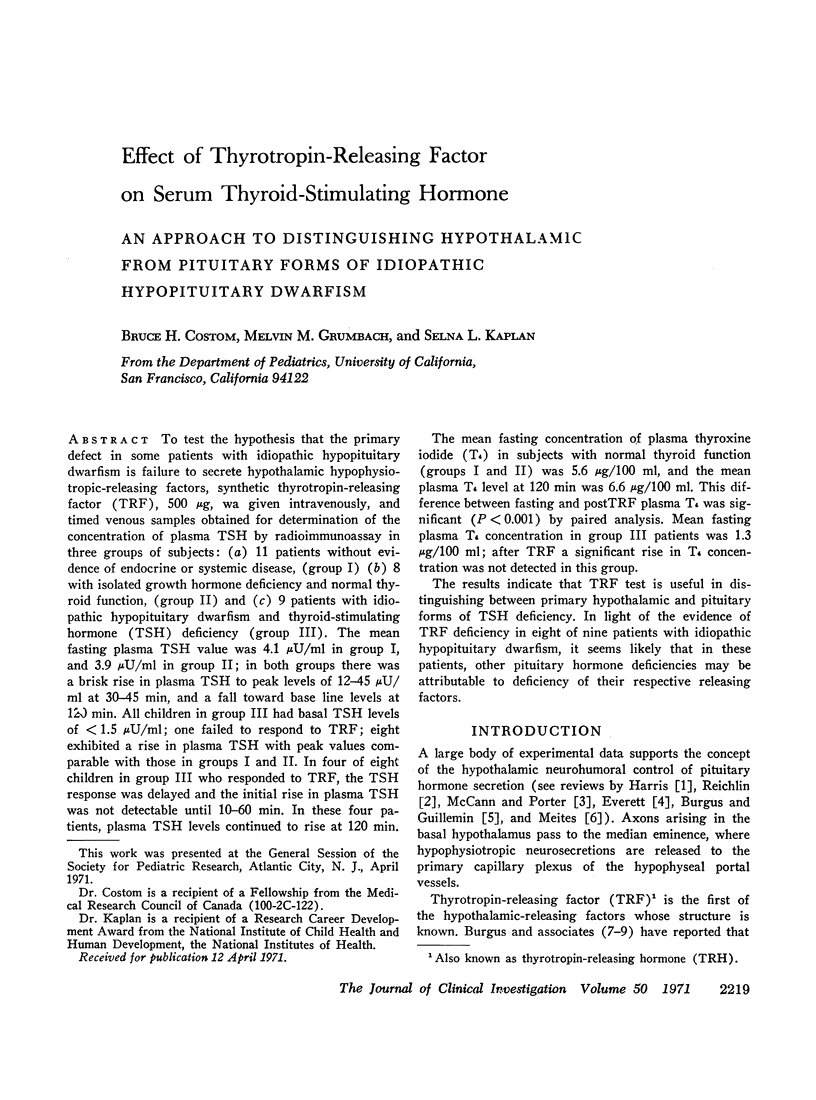
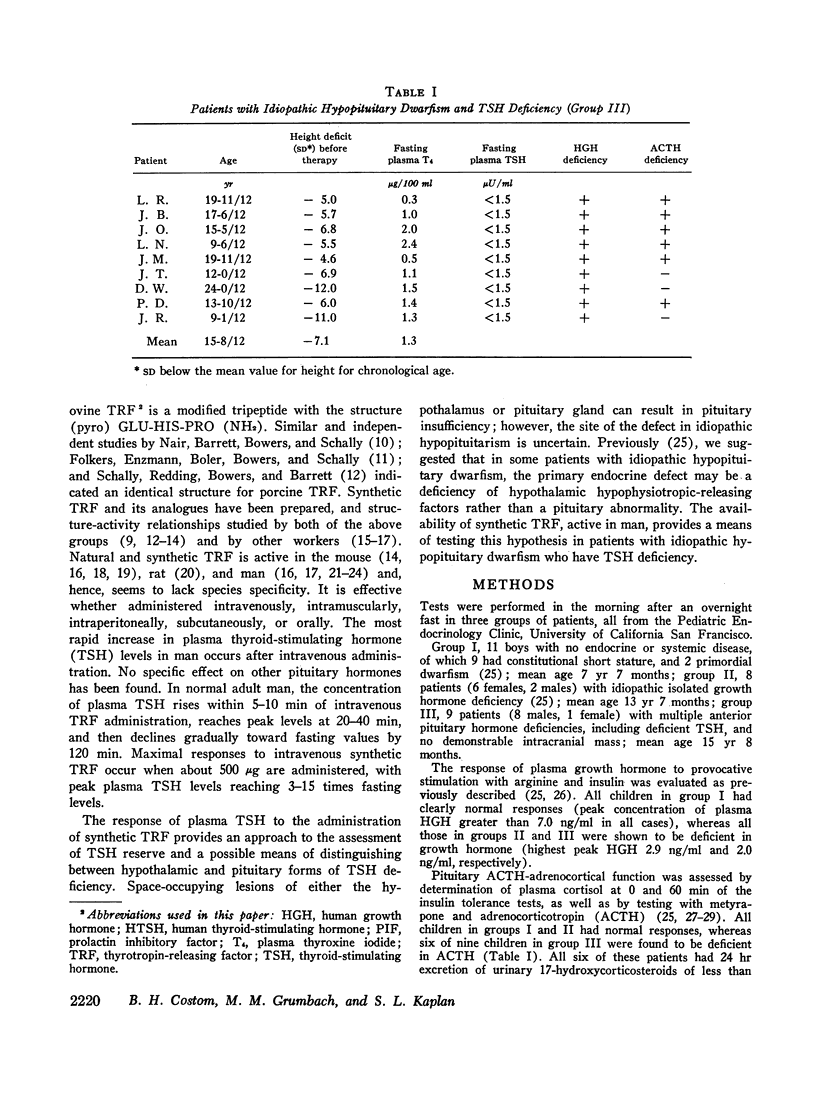
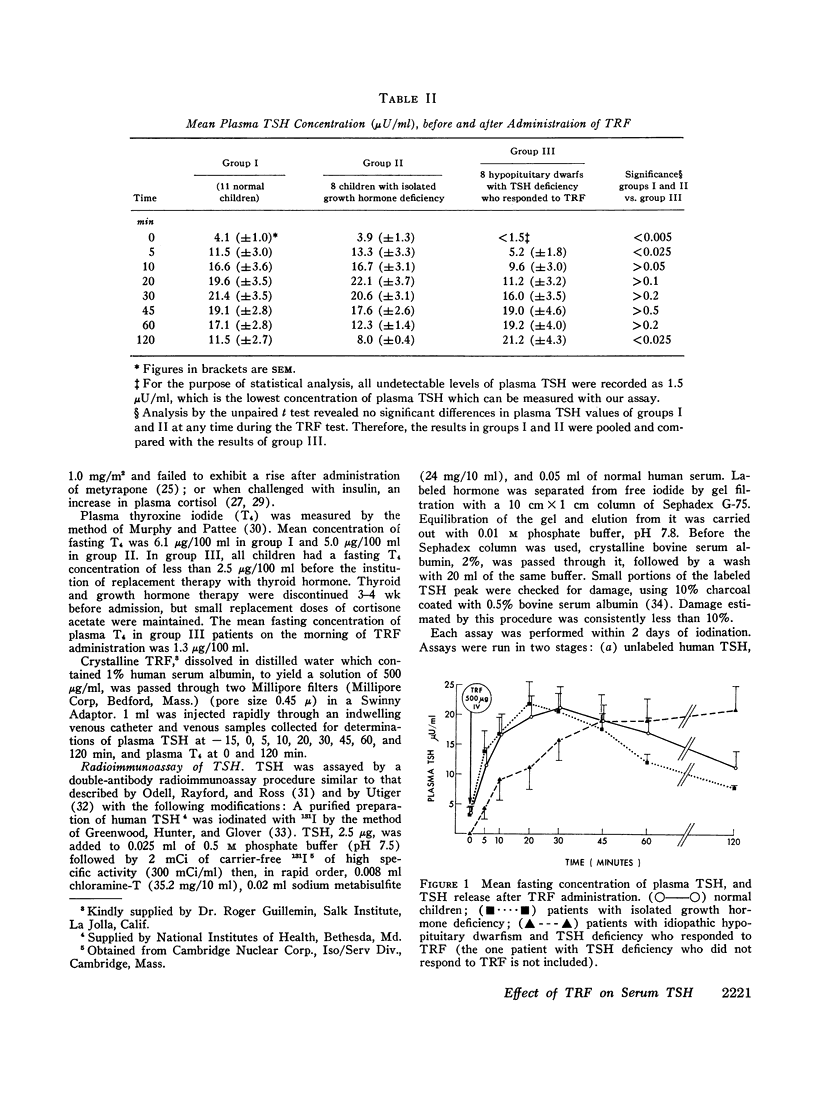
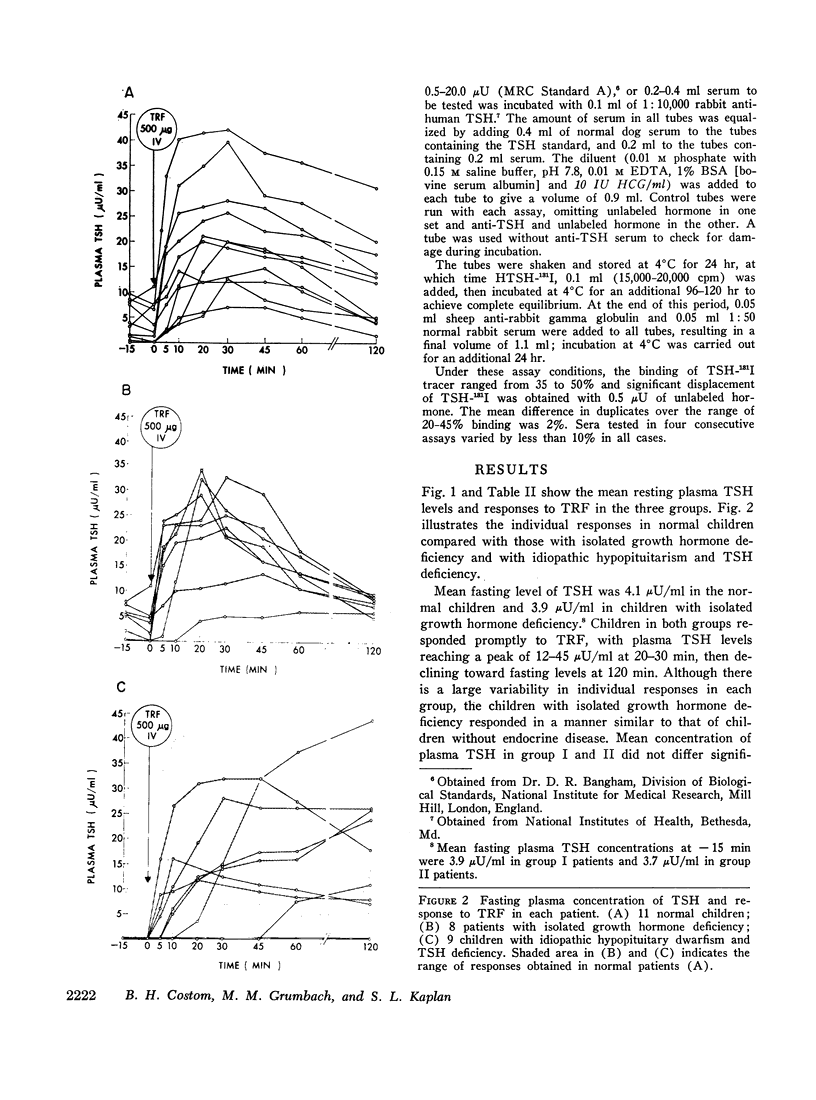
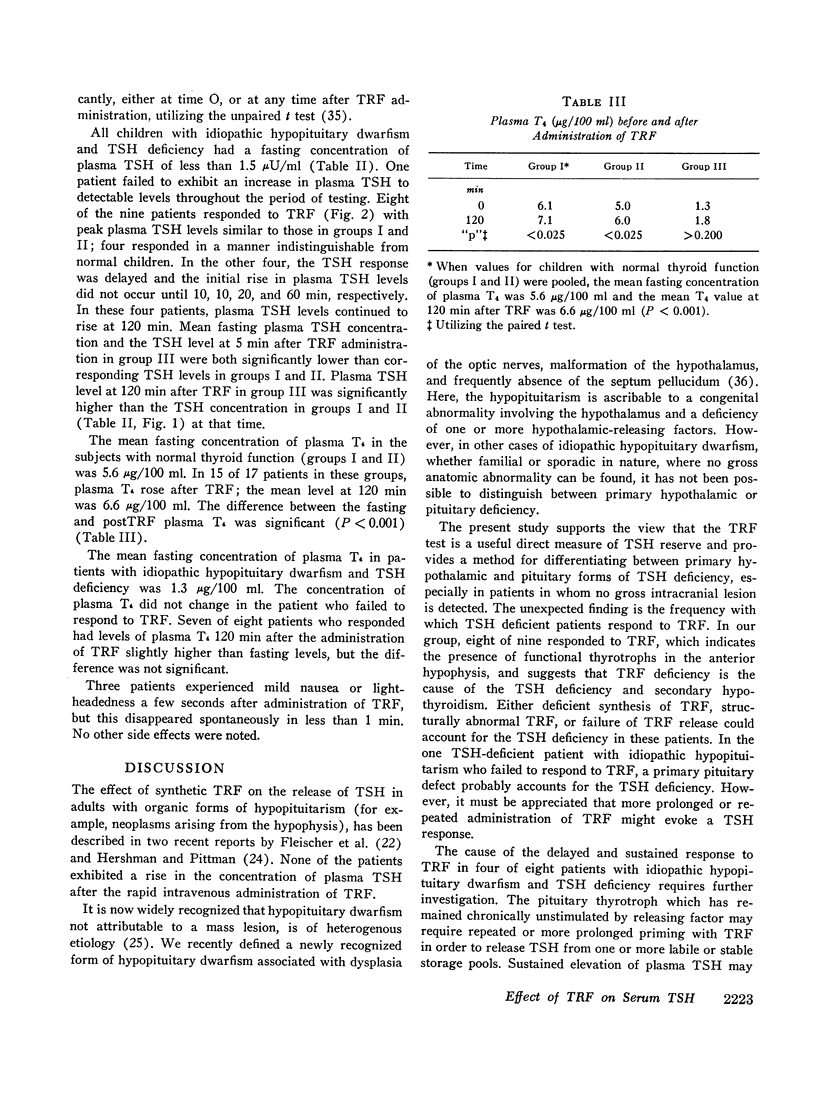
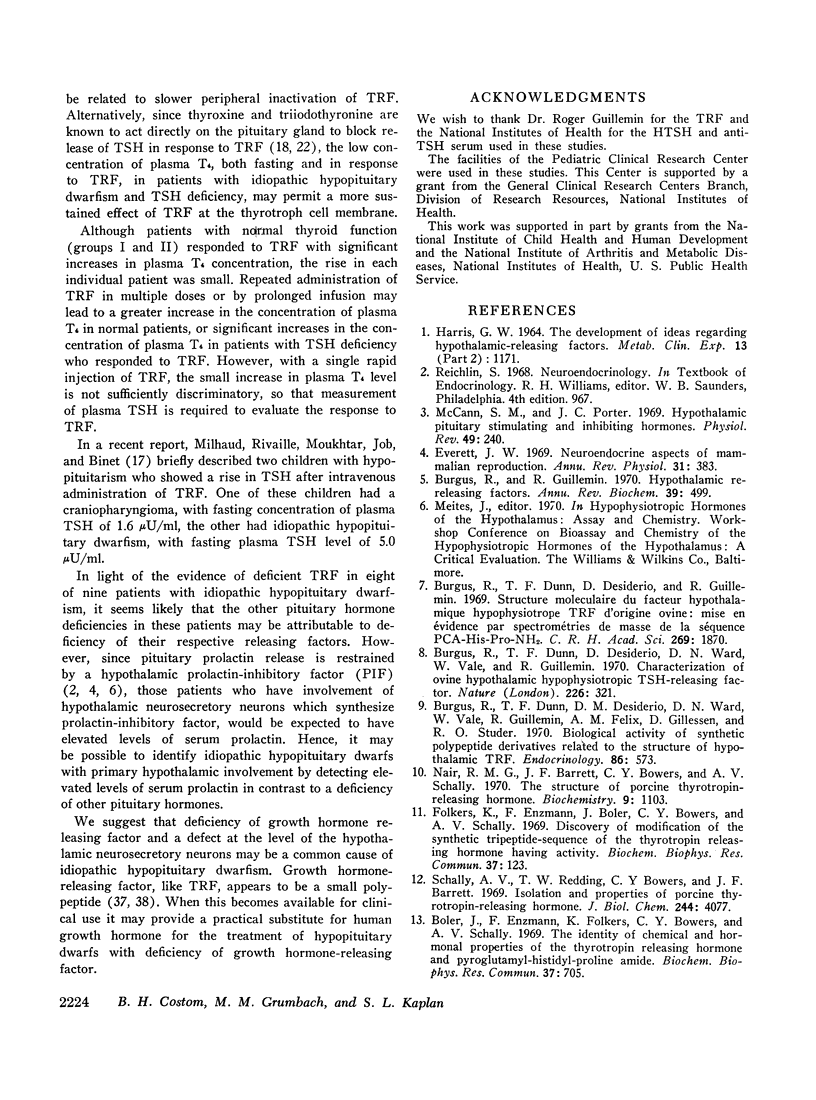
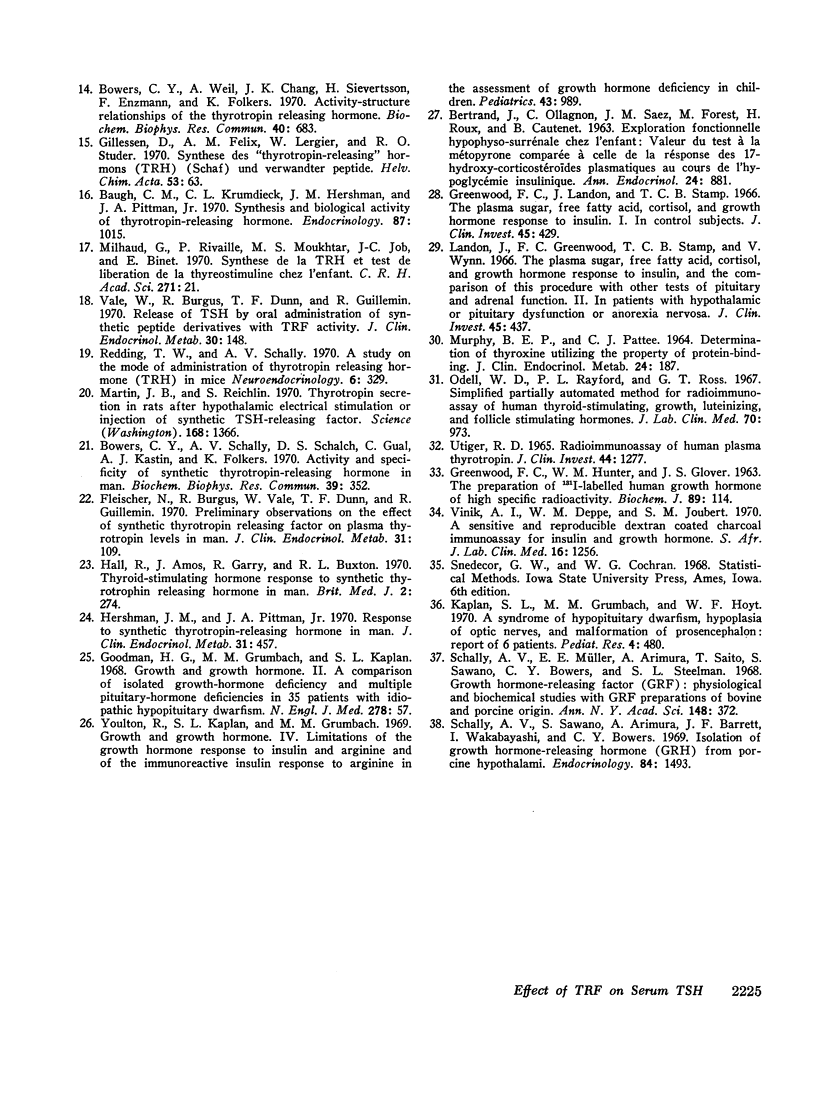
Images in this article
Selected References
These references are in PubMed. This may not be the complete list of references from this article.
- BERTRAND J., OLLAGNON C., SAEZ J. M., FOREST M., ROUX H., CAUTENET B. EXPLORATION FONCTIONELLE HYPOPHYSO-SURR'ENALE CHEZ L'ENFANT: VALEUR DU TEST 'A LA M'ETOPYRONE COMPAR'EE 'A CELLE DE LA R'EPONSE DES 17-HYDROXY-CORTICOST'EROUIDES PLASMATIQUES AU COURS DE L'HYPOGLYC'EMIE INSULINIQUE. Ann Endocrinol (Paris) 1963 Sep-Oct;24:881–887. [PubMed] [Google Scholar]
- Baugh C. M., Krumdieck C. L., Hershman J. M., Pittman J. A., Jr Synthesis and biological activity of thyrotropin-releasing hormone. Endocrinology. 1970 Nov;87(5):1015–1021. doi: 10.1210/endo-87-5-1015. [DOI] [PubMed] [Google Scholar]
- Boler J., Enzmann F., Folkers K., Bowers C. Y., Schally A. V. The identity of chemical and hormonal properties of the thyrotropin releasing hormone and pyroglutamyl-histidyl-proline amide. Biochem Biophys Res Commun. 1969 Nov 6;37(4):705–710. doi: 10.1016/0006-291x(69)90868-7. [DOI] [PubMed] [Google Scholar]
- Bowers C. Y., Schally A. V., Schalch D. S., Gual C., Kastin A. J., Folkers K. Activity and specificity of synthetic thyrotropin-releasing hormone in man. Biochem Biophys Res Commun. 1970 May 11;39(3):352–355. doi: 10.1016/0006-291x(70)90583-8. [DOI] [PubMed] [Google Scholar]
- Bowers C. Y., Weil A., Chang J. K., Sievertsson H., Enzmann F., Folkers K. Activity-structure relationships of the thyrotropin releasing hormone. Biochem Biophys Res Commun. 1970 Aug 11;40(3):683–691. doi: 10.1016/0006-291x(70)90958-7. [DOI] [PubMed] [Google Scholar]
- Burgus R., Dunn T. F., Desiderio D. M., Ward D. N., Vale W., Guillemin R., Felix A. M., Gillessen D., Studer R. O. Biological activity of synthetic polypeptide derivatives related to the structure of hypothalamic TRF. Endocrinology. 1970 Mar;86(3):573–582. doi: 10.1210/endo-86-3-573. [DOI] [PubMed] [Google Scholar]
- Burgus R., Dunn T. F., Desiderio D., Guillemin R. Structure moléculaire du facteur hypothalamique hypophysiotrope TRF d'origine ovine: mise en évidence par spectrométrie de masse de la séquence PCA-His-Pro-NH2. C R Acad Sci Hebd Seances Acad Sci D. 1969 Nov 12;269(19):1870–1873. [PubMed] [Google Scholar]
- Burgus R., Dunn T. F., Desiderio D., Ward D. N., Vale W., Guillemin R. Characterization of ovine hypothalamic hypophysiotropic TSH-releasing factor. Nature. 1970 Apr 25;226(5243):321–325. doi: 10.1038/226321a0. [DOI] [PubMed] [Google Scholar]
- Burgus R., Guillemin R. Hypothalamic releasing factors. Annu Rev Biochem. 1970;39:499–526. doi: 10.1146/annurev.bi.39.070170.002435. [DOI] [PubMed] [Google Scholar]
- Everett J. W. Neuroendocrine aspects of mammalian reproduction. Annu Rev Physiol. 1969;31:383–416. doi: 10.1146/annurev.ph.31.030169.002123. [DOI] [PubMed] [Google Scholar]
- Fleischer N., Burgus R., Vale W., Dunn T., Guillemin R. Preliminary observations on the effect of synthetic thyrotropin releasing factor on plasma thyrotropin levels in man. J Clin Endocrinol Metab. 1970 Jul;31(1):109–112. doi: 10.1210/jcem-31-1-109. [DOI] [PubMed] [Google Scholar]
- Folkers K., Enzmann F., Boler J., Bowers C. Y., Schally A. V. Discovery of modification of the synthetic tripeptide-sequence of the thyrotropin releasing hormone having activity. Biochem Biophys Res Commun. 1969 Sep 24;37(1):123–126. doi: 10.1016/0006-291x(69)90889-4. [DOI] [PubMed] [Google Scholar]
- GREENWOOD F. C., HUNTER W. M., GLOVER J. S. THE PREPARATION OF I-131-LABELLED HUMAN GROWTH HORMONE OF HIGH SPECIFIC RADIOACTIVITY. Biochem J. 1963 Oct;89:114–123. doi: 10.1042/bj0890114. [DOI] [PMC free article] [PubMed] [Google Scholar]
- Gillessen D., Felix A. M., Lergier W., Studer R. O. Synthese des "Thyrotropin-releasing" Hormons (TRH) (Schaf) und verwandter Peptide. Helv Chim Acta. 1970;53(1):63–72. doi: 10.1002/hlca.19700530107. [DOI] [PubMed] [Google Scholar]
- Goodman H. G., Grumbach M. M., Kaplan S. L. Growth and growth hormone. II. A comparison of isolated growth-hormone deficiency and multiple pituitary-hormone deficiencies in 35 patients with idiopathic hypopituitary dwarfism. N Engl J Med. 1968 Jan 11;278(2):57–68. doi: 10.1056/NEJM196801112780201. [DOI] [PubMed] [Google Scholar]
- Greenwood F. C., Landon J., Stamp T. C. The plasma sugar, free fatty acid, cortisol, and growth hormone response to insulin. I. In control subjects. J Clin Invest. 1966 Apr;45(4):429–436. doi: 10.1172/JCI105357. [DOI] [PMC free article] [PubMed] [Google Scholar]
- HARRIS G. W. THE DEVELOPMENT OF IDEAS REGARDING HYPOTHALAMIC-RELEASING FACTORS. Metabolism. 1964 Oct;13:SUPPL–SUPPL:1176. doi: 10.1016/s0026-0495(64)80034-2. [DOI] [PubMed] [Google Scholar]
- Hall R., Amos J., Garry R., Buxton R. L. Thyroid-stimulating hormone response to synthetic thyrotrophin releasing hormone in man. Br Med J. 1970 May 2;2(5704):274–277. doi: 10.1136/bmj.2.5704.274. [DOI] [PMC free article] [PubMed] [Google Scholar]
- Hershman J. M., Pittman J. A., Jr Response to synthetic thyrotropin-releasing hormone in man. J Clin Endocrinol Metab. 1970 Oct;31(4):457–460. doi: 10.1210/jcem-31-4-457. [DOI] [PubMed] [Google Scholar]
- Landon J., Greenwood F. C., Stamp T. C., Wynn V. The plasma sugar, free fatty acid, cortisol, and growth hormone response to insulin, and the comparison of this procedure with other tests of pituitary and adrenal function. II. In patients with hypothalamic or pituitary dysfunction or anorexia nervosa. J Clin Invest. 1966 Apr;45(4):437–449. doi: 10.1172/JCI105358. [DOI] [PMC free article] [PubMed] [Google Scholar]
- MURPHY B. E., PATTEE C. J. DETERMINATION OF THYROXINE UTILIZING THE PROPERTY OF PROTEIN-BINDING. J Clin Endocrinol Metab. 1964 Feb;24:187–196. doi: 10.1210/jcem-24-2-187. [DOI] [PubMed] [Google Scholar]
- Martin J., Reichlin S. Thyrotropin secretion in rats after hypothalamic electrical stimulation or injection of synthetic TSH-releasing factor. Science. 1970 Jun 12;168(3937):1366–1368. doi: 10.1126/science.168.3937.1366. [DOI] [PubMed] [Google Scholar]
- McCann S. M., Porter J. C. Hypothalamic pituitary stimulating and inhibiting hormones. Physiol Rev. 1969 Apr;49(2):240–284. doi: 10.1152/physrev.1969.49.2.240. [DOI] [PubMed] [Google Scholar]
- Nair R. M., Barrett J. F., Bowers C. Y., Schally A. V. Structure of porcine thyrotropin releasing hormone. Biochemistry. 1970 Mar 3;9(5):1103–1106. doi: 10.1021/bi00807a008. [DOI] [PubMed] [Google Scholar]
- Odell W. D., Rayford P. L., Ross G. T. Simplified, partially automated method for radioimmunoassay of human thyroid-stimulating, growth, luteinizing, and follicle stimulating hormones. J Lab Clin Med. 1967 Dec;70(6):973–980. [PubMed] [Google Scholar]
- Redding T. W., Schally A. V. A study on the mode of administration of thyrotropin releasing hormone (TRH) in mice. Neuroendocrinology. 1970;6(5):329–335. doi: 10.1159/000121938. [DOI] [PubMed] [Google Scholar]
- Schally A. V., Muller E. E., Arimura A., Saito T., Sawano S., Bowers C. Y., Steelman S. L. Growth hormone-releasing factor (GRF): physiological and biochemical studies with GRF preparations of bovine and porcine origin. Ann N Y Acad Sci. 1968 Feb 5;148(2):372–388. doi: 10.1111/j.1749-6632.1968.tb20364.x. [DOI] [PubMed] [Google Scholar]
- Schally A. V., Redding T. W., Bowers C. Y., Barrett J. F. Isolation and properties of porcine thyrotropin-releasing hormone. J Biol Chem. 1969 Aug 10;244(15):4077–4088. [PubMed] [Google Scholar]
- Schally A. V., Sawano S., Arimura A., Barrett J. F., Wakabayashi I., Bowers C. Y. Isolation of growth hormone-releasing hormone(GRH) from porcine hypothalami. Endocrinology. 1969 Jun;84(6):1493–1506. doi: 10.1210/endo-84-6-1493. [DOI] [PubMed] [Google Scholar]
- UTIGER R. D. RADIOIMMUNOASSAY OF HUMAN PLASMA THYROTROPIN. J Clin Invest. 1965 Aug;44:1277–1286. doi: 10.1172/JCI105234. [DOI] [PMC free article] [PubMed] [Google Scholar]
- Vale W., Burgus R., Dunn T. F., Guillemin R. Release of TSH by oral administration of synthetic peptide derivatives with TRF activity. J Clin Endocrinol Metab. 1970 Jan;30(1):148–150. doi: 10.1210/jcem-30-1-148. [DOI] [PubMed] [Google Scholar]
- Youlton R., Kaplan S. L., Grumbach M. M. Growth and growth hormone. IV. Limitations of the growth hormone response to insulin and arginine and of the immunoreactive insulin response to arginine in the assessment of growth hormone deficiency in children. Pediatrics. 1969 Jun;43(6):989–1004. [PubMed] [Google Scholar]




